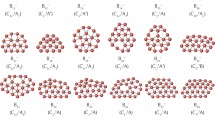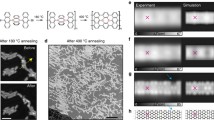Abstract
Motivated by experimental observation of B36 borophene as a molecular model of bulk boron, here, we report the impact of nitrogen substitution on the electronic and chemical properties of neutral and anionic B36 clusters. Three N-doped configurations resulted from nitrogen substitution at different positions with respect to the central hexagonal hole of B36 are considered. The effect of N-doping on the structure, curvature, and π bonding pattern of the B36 is analyzed. High level of N-dopant enhances the curvature, and the cluster adopts a buckled form. We also study the binding strength between alkali metals with the pristine and N-doped substrates. Moreover, the adsorption properties of metallized substrates toward H2 molecule are explored, highlighting the role of dopant. Depending on the type of metal and the nitrogen content, the H2 adsorption energies vary in the range between − 0.11 and − 0.21 eV which fall into the range for the practical applications.













Similar content being viewed by others
References
Kiran B, Bulusu H, Zhai HJ, Yoo S, Zeng XC, Wang LS (2005) Planar-to-tubular structural transition in boron clusters: B20 as the embryo of single-walled boron nanotubes. Proc Natl Acad Sci USA 102:961–964
Huang W, Sergeeva AP, Zhai HJ, Averkiev BB, Wang LS, Boldyrev AIA (2010) Concentric planar doubly π-aromatic B19 − cluster. Nat Chem 2:202–206
Popov IA, Piazza ZA, Li WL, Wang LS, Boldyrev AI (2013) A combined photoelectron spectroscopy and ab initio study of the quasi-planar B24(-) cluster. J Chem Phys 139:144307-1–144307-8
Oger E, Crawford NRM, Kelting R, Weis P, Kappes MM, Ahlrichs R (2007) Boron cluster cations: transition from planar to cylindrical structures. Angew Chem Int Ed 46:8503–8506
Aihara JI, Kanno H, Ishida T (2005) Aromaticity of planar boron clusters confirmed. J Am Chem Soc 127:13324–13330
Liu CH, Wang X, Ye XJ, Yan X, Zeng Z (2014) Curvature and ionization-induced reversible hydrogen storage in metalized hexagonal B36. J Chem Phys 141:194306-1–194306-8
Mukherjee S, Thilagar P (2016) Borophene: a new paradigm! Curr Sci 111:1302–1304
Mannix AJ, Zhou XF, Kiraly B, Wood J, Alducin DD, Myers BD, Liu X, Fisher BL, Santiago U, Guest JR et al (2015) Synthesis of borophenes: anisotropic, two-dimensional boron polymorphs. Science 350:1513–1516
Sachdev H (2015) Disclosing boron’s thinnest side. Science 350:1468–1469
Tang H, Beigi S (2007) Novel precursors for boron nanotubes: the competition of two-center and three-center bonding in boron sheets. Phys Rev Lett 99:115501-1–115501-4
Yang X, Ding Y, Ni J (2008) Ab initio prediction of stable boron sheets and boron nanotubes: structure, stability, and electronic properties. Phys Rev B 77:041402-1–041402-4
Balendhran S, Walia S, Nili H, Sriam S, Bhaskaran M (2015) Elemental analogues of graphene: silicene, germanene, stanene, and phosphorene. Small 11:640–652
Sachdev H, Muller F, Hufner S (2010) BN analogues of graphene: on the formation mechanism of boronitrene layers—solids with extreme structural anisotropy. Diamond Relat Mater 19:1027–1033
Sergeeva PA, Popov IA, Piazza ZA, Li WL, Romanescu C, Wang L, Boldyrev AI (2014) Understanding boron through size-selected clusters: structure, chemical bonding, and fluxionality. Acc Chem Res 47:1349–1358
Li S, Zhang Z, Long Z, Sun G, Qin S (2016) Comparative study on the spectral properties of boron clusters Bn0/−1(n = 38–40). Sci Rep 6:25020-1–25020-9
Piazza ZA, Hu HS, Li WL, Zhao YF, Li J, Wang LS (2014) Planar hexagonal B36 as a potential basis for extended single-atom layer boron sheets. Nat Commun 5:3113-1–3113-6
Li WL, Chen Q, Tian WJ, Bai H, Zhao YF, Hu HS, Zhai HJ, Li D, Wang LS (2014) The B35 cluster with a double-hexagonal vacancy: a new and more flexible structural motif for borophene. J Am Chem Soc 136:12257–12260
Rastgou A, Soleymanabadi H, Bodaghi A (2017) DNA sequencing by borophene nanosheet via an electronic response: a theoretical study. Microelectron Eng 169:9–15
Kootenaei A, Ansari G (2016) B36. borophene as an electronic sensor for formaldehyde: quantum chemical analysis. Phys Lett A 380:2664–2668
Jiang HR, Lu Z, Wu MC, Ciucci F, Zhao TS (2016) Borophene: a promising anode material offering high specific capacity and high rate capability for lithium-ion batteries. Nano Energy 23:97–104
Zhang X, Hu J, Cheng Y, Yang H, Yau Y, Yang SA (2016) Borophene as an extremely high capacity electrode material for Li-ion and Na-ion batteries. Nanoscale 8:15340–15347
Shi L, Zhao T, Xu A, Xu J (2016) Ab initio prediction of borophene as an extraordinary anode material exhibiting ultrafast directional sodium diffusion for sodium-based batteries. Sci Bull 61:1138–1144
Zhao Y, Zeng S, Ni J (2016) Phonon-mediated superconductivity in borophenes. App Phys Lett 108:242601-1–242601-4
Zhang Y, Wu ZF, Gao PF, Zhang S, Wen Y (2016) Could borophene be used as a promising anode material for high-performance li ion battery? ACS Appl Mater Interfaces 8:2175–22181
Meng F, Chen X, Sun S, He J (2017) Electronic and magnetic properties of pristine and hydrogenated borophene nanoribbons. Phys E 91:106–112
Ataca C, Akturk E, Ciraci S, Ustunel H (2008) High-capacity hydrogen storage by metallized graphene. Appl Phys Lett 93:043123–043125
Kim D, Lee S, Hwang Y, Yun K, Chung Y (2014) hydrogen storage in li dispersed graphene with stone–wales defects: a first-principles study. Int J Hydrog Energy 39:13189–13194
Yoon M, Yang S, Hicke C, Wang E, Geohegan D, Zhang Z (2008) Calcium as the superior coating metal in functionalization of carbon fullerenes for high-capacity hydrogen storage. Phys Rev Lett 100:206806–206809
Chen C, Zhang J, Zhang B, Duan H (2013) Hydrogen adsorption of mg-doped graphene oxide: a first-principles study. J Phys Chem C 117:4337–4344
Cabria I, Lopez MJ, Fraile S, Alonso J (2012) Adsorption and dissociation of molecular hydrogen on palladium clusters supported on graphene. J Phys Chem C 116:21179–21189
Guo Y, Lan X, Cao J, Xu B, Xia Y, Yin J (2013) A comparative study of the reversible hydrogen storage behavior in several metal decorated graphyne. Int J Hydrog Energy 38:3987–3993
Zhang H, Zhao M, Bu H, He X, Zhang M, Zhao L, Luo Y (2012) Ultra-high hydrogen storage capacity of li-decorated graphyne: a first-principles prediction. J Appl Phys 112:084305-1–084305-5
Lu RF, Rao D, Meng Z, Zhang X, Xu G, Liu Y, Kan E, Xiao C, Deng K (2013) Boron-substituted graphyne as a versatile material with high storage capacities of Li and H2: a multiscale theoretical study. Phys Chem Chem Phys 15:16120–16126
Wan W, Wang H (2015) First-principles investigation of adsorption and diffusion of ions on pristine, defective and B-doped graphene. Materials 8:6163–6178
Rao D, Zhang L, Meng Z, Zhang X, Wang Y, Qiao G, Shen X, Liu J, Lu F (2017) Ultrahigh energy storage and ultrafast ion diffusion in borophene-based anodes for rechargeable metal ion batteries. J Mater Chem A 5:2328–2338
Zhou J, Wang Q, Sun Q, Jena P, Chen XS (2010) Electric field enhanced hydrogen storage on polarizable materials substrates. Proc Natl Acad Sci USA 107:2801–2806
Hussain T, Islam MS, Rao GS, Panigrahi P, Gupta D, Ahuja R (2015) Hydrogen storage properties of light metal adatoms (Li, Na) decorated fluorographene monolayer. Nanotechnology 26:275401-1–275401-6
Li FY, Jin P, Jiang DE, Wang L, Zhang SB, Zhaoand JJ, Chen ZF (2012) B80 and B101-103 clusters: remarkable stability of the core-shell structures established by validated density functionals. J Chem Phys 136:74302-1–074302-8
Bai H, Chen Q, Miao C, Qmu YW, Wu YB, Lu GH, Zhai HJ, Li SD (2013) Ribbon aromaticity in double-chain planar BnH22 − and Li2BnH2 nanoribbon clusters up to n = 22: lithiated boron dihydride analogues of polyenes. Phys Chem Chem Phys 15:18872–18880
Romanescu C, Harding DJ, Fielicke A, Wang LS (2012) Probing the structures of neutral boron clusters using infrared/vacuum ultraviolet two color ionization: B11, B16, and B17. J Chem Phys 137:014317-1–014317-6
Frisch MJ, Trucks GW, Schlegel HB, Scuseria GE, Robb MA, Cheeseman JR, Scalmani G, Barone V, Mennucci B, Petersson GA, et al (2013) Gaussian 09, revision D.01: Gaussian, Inc: Wallingford CT
Zubarev DY, Boldyrev AI (2008) A developing paradigms of chemical bonding: adaptive natural density partitioning. Phys Chem Chem Phys 10:5207–5217
Lu T Multiwfn, version 3.3.9. http://multiwfn.codeplex.com/
Lu T, Chen F (2012) Multiwfn: a multifunctional wavefunction analyzer. J Comp Chem 33:580–592
Chen Q, Wei GF, Tian WJ, Bai H, Liu ZP, Zhai HJ, Li SD (2014) Quasi-planar aromatic B36 and B36 − clusters: all-boron analogues of coronene. Phys Chem Chem Phys 16:18282–18287
Wang LS, Zhai HJ, Li SD, Li J, Boldy AI (2016) From planar boron clusters to borophene and borospherene. Proc of SPIE 10174:1017402-1–1017402-9
Legrian F, Manzhos S (2015) Aluminum doping improves the energetics of lithium, sodium, and magnesium storage in silicon. J Power Sources 274:65–70
Mohajeri A, Shahsavar A (2017) Tailoring the optoelectronic properties of graphyne and graphdiyne: nitrogen/sulfur dual doping versus oxygen containing functional groups. J Mater Sci 52:5366–5379
Zhou Z, Gao X, Yan J, Song D (2006) Doping effects of B and N on hydrogen adsorption in single-walled carbon nanotubes through density functional calculations. Carbon 44:939–947
Correa DJ, Florez F, Mora-Ramosb ME (2016) Ab initio study of hydrogen chemisorption in nitrogen-doped carbon nanotubes. Phys Chem Chem Phys 18:25663–25670
Acknowledgements
This work is supported by the Shiraz University Research Council.
Author information
Authors and Affiliations
Corresponding author
Ethics declarations
Conflict of interest
There is no conflict of interest regarding the publication of this article.
Electronic supplementary material
Below is the link to the electronic supplementary material.
10853_2017_1900_MOESM1_ESM.docx
The structural properties of base and doped borophene as well as hydrogen adsorption properties for metallized substrates are given in supplementary material. (DOCX 336 kb)
Rights and permissions
About this article
Cite this article
Shahsavar, A., Mohajeri, A. Impact of position and number of nitrogen atom substitution on the curvature and hydrogen adsorption properties of metallized borophene. J Mater Sci 53, 4540–4553 (2018). https://doi.org/10.1007/s10853-017-1900-1
Received:
Accepted:
Published:
Issue Date:
DOI: https://doi.org/10.1007/s10853-017-1900-1




